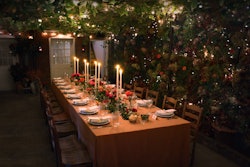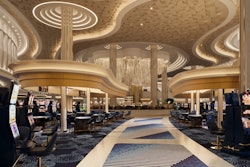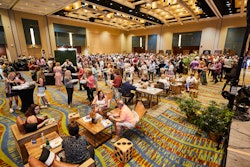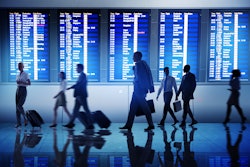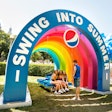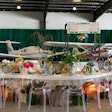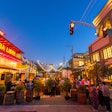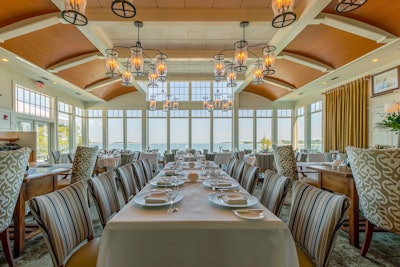
Private dining rooms (PDRs) are no longer just for intimate dinner parties. Instead, various restaurants throughout the U.S. are incorporating event-friendly elements into their venues to accommodate everything from influencer lunches and brand launches to corporate conferences and award banquets. We spoke with 10 event-minded professionals in the restaurant industry for tips on how to integrate everything from retractable walls to Instagram-worthy views to full-blown bocce courts to attract the ever-growing event masses.
1. When it comes to amenities, never settle.
COTE Miami is a wildly popular upscale Korean steakhouse in the posh Design District where hospitality is second to none. At this lively Michelin-starred outpost, servers take care of the cooking at tableside grills that reach up to 700 degrees to present multicourse interactive dining experiences with USDA Prime, American wagyu, Japanese A5 wagyu cuts, and authentic sides taking center stage.
This signature service is also extended to the Pineapple King Room, which seats up to 10 diners for private events and contains two grills—one on each side of the table. “The most unique quality of our PDR is our signature grill-top tables, where every morsel of steak is grilled to perfection in front of you,” says Amy Zhou, director of operations and partner. COTE’s Pineapple King Room also offers YETI coolers on demand for parties who want in-room bottle service, as well as a private audio system for customized tunes and a hidden flat-screen TV for personal viewings, game season, and DIY karaoke parties.
Zhou feels the most important components offered by a great PDR are style, comfort, and energy. “With PDRs, you're often paying the price of energy in return for privacy,” she explains. “Don't settle. Pick a PDR that has great finishes and amenities, so you're not skipping a beat.”
2. Segment larger rooms for a welcome reception.
When you envision your event taking place in a private dining room, consider the space’s ability to break out and host more than one main event. At Bourbon Steak DC, which offers beautiful views of the C&O Canal in the heart of Georgetown, the team uses an airwall to split the 38-person, 480-square-foot private dining space into two rooms as needed: Batch and Spirit—which can also allow for a welcome reception.
“A trend I'm seeing is beginning with a cocktail reception,” says Erich Stumpe, general manager of Bourbon Steak DC. “With our guests, this gives them a more well-rounded experience, with a variety of options including canapes and stationed appetizers that allow us to activate different parts of the space for guests to enjoy as they mingle.”
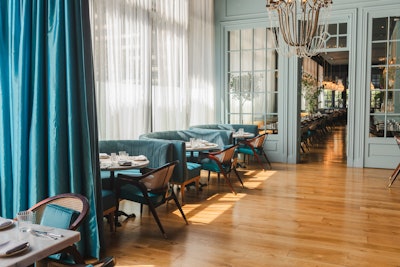 In the daytime, the curtains of the 800-square-foot, 50-seat private dining room at Baar Baar Los Angeles can be closed or drawn depending on the event scope.Photo: Regan Norton
In the daytime, the curtains of the 800-square-foot, 50-seat private dining room at Baar Baar Los Angeles can be closed or drawn depending on the event scope.Photo: Regan Norton
3. Lighting is key.
At Baar Baar Los Angeles, an Indian eatery with Victorian-inspired design, private events are always curated with lighting top of mind. “The classic Victorian elegance lies in the chandeliers with a vintage appearance that gives the space a grand feel,” says partner Jyoti Vira. In the daytime, the curtains of the 800-square-foot, 50-seat private dining room can be closed or drawn depending on the event scope. “It is a versatile space where tables can be rearranged and lighting can be adjusted to fit the needs of the event. Lighting is essential to fit in with the vision and is agreed upon beforehand.”
Because the space sees plenty of media, influencer, and brand-centric events, lighting is an important factor when photography takes place. “Looking ahead, we hope to evolve our PDRs by integrating elements that enhance both the functionality and the aesthetic appeal of the space. We envision adaptable lighting that can be fine-tuned to match the mood of any event,” Vira says.
4. Be mindful of the flow.
Gufo in Boston sports a unique indoor-outdoor patio space that is surrounded by 8-foot wooden fencing, which creates a private setting within an urban city environment. The Italian restaurant’s private patio includes a bocce court, fire pit, and covered patio that is enclosed and heated so it can be utilized during the chillier months.
“Our space is uniquely long and narrow, so it’s important to communicate ‘flow’ to guests and help them understand how versatile our space truly is in its ability to accommodate a range of event styles from social cocktails to a seated dinner,” says director of events Meg Warner. “Help your guests and clients understand the importance of flow from the beginning of the planning process. Having a station set up for wine/beverages, even if it is not necessarily a full bar, gives guests a clear place of where to go to get/order drinks.”
5. Ask about customizability—and outside vendor limitations.
In Washington, D.C., Via Sophia at Hamilton Hotel’s PDR prides itself on being intimate, cozy, and a true extension of the restaurant—without being attached, which lends to a sense of exclusivity. Regional director of food and beverage Joseph Palminteri says the customizability of the space is the most important feature, however.
“Personalized touches, such as custom place cards, florals, various decor, AV, and branded items, are all great tips to make your gathering unique and memorable,” he shares. “It’s also important to ask in advance if there are any limitations to bringing in outside vendors rather than working with ‘preferred vendors.’”
6. Choose an Instagram-worthy view.
It’s no secret that organic social media is a great source of free advertising for exceptional venues. At Tiki Hut in Hilton Head Island, S.C., director of food and beverage at Beach House Matt Suckow says the venue takes full advantage of this with its 20-person private tiki hut for events.
“One of the best views on the island, sitting above the treetop, gives guests an Instagram-worthy view of the beautiful beach and ocean,” he explains. “Lit up by tiki torches in the evenings, this private area allows guests to relax, have drinks with friends, and create memories.”
In order to achieve this task, Suckow says the venue must have a vibe that connects to the guest and enhances the enjoyment. “If it's a true, genuine experience, it will create a seamless connection,” he says.
7. Find the "wow" factor.
Whether new or newly renovated, many PDRs are going above and beyond to offer state-of-the-art tech features to appeal specifically to the private event crowd. Debuting in early December, Nicco’s Prime Cuts & Fresh Fish at the new $780 million Durango Casino & Resort in Las Vegas pulled out all the bells and whistles for its forthcoming Veranda Room. Renee Di Liddo, director of sales and catering, asks, “Does the space completely wow guests?”
To illustrate, the Verdanda Room will be a fully enclosed glass room that features a glass ceiling and full-length retractable walls. These will open up to surrounding water features and into an additional private seating garden with more water features and a large oak tree in the center of the open-air space. Plus, there are two other air-wall-connected PDRs and a private bar.
“The future of PDRs is definitely natural lighting, stunning views, indoor and alfresco dining, turnkey AV options that the guest can control easily, high-quality sound systems, and dedicated Wi-Fi and internet," Di Liddo says.
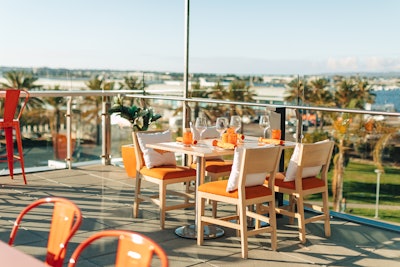 Garibaldi at InterContinental San Diego is an Italian-isle-inspired rooftop restaurant that offers unique and adaptable private event space for corporate and social groups.Photo: Diana Rose
Garibaldi at InterContinental San Diego is an Italian-isle-inspired rooftop restaurant that offers unique and adaptable private event space for corporate and social groups.Photo: Diana Rose
8. Be mindful when it comes to layout.
Private dining rooms are for more than just dining. Garibaldi at InterContinental San Diego is an Italian-isle-inspired rooftop restaurant that offers unique and adaptable private event space for corporate and social groups. The venue has been used in multiple event contexts, from food and wine tastings to weddings to art installations.
Restaurant catering sales manager Jacqueline Coligan says all-around mindfulness is important when considering the event’s programming. “You’ll definitely want to make sure there’s plenty of room to mix and mingle before guests take their seats. If there’s a presentation, be mindful of how seats are positioned so everyone has an easy time seeing the screen or speaker. Place food stations mindfully, careful to not obstruct views.”
9. When faced with multiple options, remember what you want your event to achieve.
Sometimes, you may get lucky and find a restaurant that has multiple private dining spaces. When you are faced with choosing the right space within one venue that offers more than one PDR option, do your homework. Orlando-based Paddlefish is located on Lake Buena Vista in Disney Springs and offers three floors of semiprivate and private spaces, both indoors and outdoors, for all types of receptions.
“Think of what you want from the beginning to best plan the space, seating, food, music, etc.,” offers Kate Harrelson, director of sales. “Each event space within a venue offers something different, and one may be better suited than the other.” For example, a rooftop deck might be more suitable for a casual mingle than a seated dinner, and a banquet room might be too large for a smaller, more intimate gathering.
10. Service should be anticipatory but never invasive.
At Twenty-Eight Atlantic at Wequassett Resort & Golf Club on Cape Cod, the PDR’s focal points are its floor-to-ceiling windows that offer views of Pleasant Bay, alongside a wine wall and other chic coastal accents. However, delivering a five-star experience at every function is its bread and butter.
“The most important feature is the five-star, fine dining experience, in addition to the ability for the team to deliver anticipatory but not invasive service,” shares Alton Chun, regional managing director of the Wequassett Resort & Golf Club dining team. “Our private dining groups are sometimes utilizing the space for a business meeting or an intimate family celebration, and it’s important that the restaurant team be acutely aware of how to deliver service in a harmonious way.”




